| Construction Rating: | starstarstarstarstar |
| Flight Rating: | starstarstarstarstar_border |
| Overall Rating: | starstarstarstarstar_border |
| Diameter: | 2.64 inches |
| Manufacturer: | Semroc  |
| Skill Level: | 2 |
| Style: | Cluster, Sport |
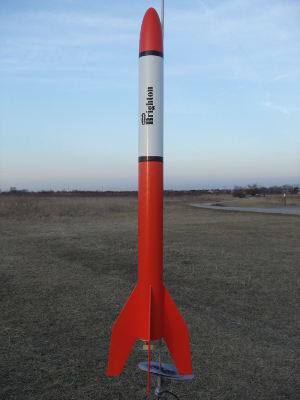
Brief:
This is essentially an upscale retro/repro of the classic Astron Ranger, but in deference to Vern Estes, Semroc
avoided naming this after one of his favorites, instead going with the Brighton. It's a fantastically engineered,
incredibly versatile rocket, featuring four different interchangeable motor configuration options: 4x18mm
cluster, 3x24mm cluster, single 29mm, or single 24mm using a 29/24 adapter. Add to all that a baffle system, and you're
looking at 17 different body tubes!
Construction:
Wow. Where to start? I'll admit I was a bit put off by the $75 retail price, but when Semroc rolled out their
traditional Christmas half-off deal for previous online/direct customers, I jumped at the chance to pick this one up.
When I finally got around to opening it, I could appreciate the price is actually a decent value as the parts
practically exploded all over my floor:
- BNC 80 balsa nose cone
- BT-80 (heavy wall) payload tube
- TC-80 coupler
- BT-80 (heavy wall) main body tube, pre-slotted for TTW fins
- Laser cut basswood fins
- 2.25" Inner motor mount receptacle tube
- 24" nylon chute
- heavy elastic shock cord
- waterslide decal
- Baffle system parts:
- 2 series 8 body tubes
- 2 plywood centering rings
- 4x18mm motor adapter parts:
- 4 BT-20 motor tubes
- 4 metal hooks
- 2 plywood centering rings
- 1 BT-70 adapter tube
- 3x24 motor adapter parts
- 3 BT-50 motor tubes (E-sized)
- 3 metal hooks
- 1 plywood centering ring
- 1 BT-70 adapter tube
- 3 TC-50 1" D-E adapter couplers/plugs
- 29mm motor adapter parts:
- 29mm heavy wall motor tube
- 2 plywood centering rings
- 1 BT-70 adapter tube
- 24/29 motor adapter kit parts:
- BT-50 heavy wall tube (E sized)
- metal hook
- motor block
- TC-50 1" D-E adapter coupler/plug
- 2 29/24 heavy wall tubes(centering rings)
The instructions cover about 50 construction steps spanning 19 small pages with plenty of good illustrations (though a few of the illustrations are on the page following the instruction, which I found to be slightly confusing). You will absolutely need to read the instructions carefully on this to avoid making boneheaded mistakes (a helpful tip I picked up from a build thread on YORF). I'll admit between the price and vast amount of parts, I was a little intimidated by this, figuring it for a long winter build project. After reading the instructions though, I realized it really wasn't too bad. Semroc rates it a skill level 2, and I'd agree. In fact, other than finishing I had this built in about 4 hours, however, I went into it with no ambition to fly HPR so I stuck with CA and wood glue for most bonds. HPR would involve use of epoxy for all motor and fin bonds, adding at least another hour to the process. I'll also point out that I did a considerable amount of jumping back and forth between subassemblies to minimize idle time in the process.
I began, as instructed, by treating the ends of all tube with thin CA to seal them up, then sanding down. I also took the liberty of applying wood filler to the relatively heavy (for Semroc) tube spirals, after first carefully reviewing the parts schematic to make sure I hit only the outside body tubes.
The first major subassembly is the engine mount holder, which serves as a receptacle for the various interchangeable motor mount adapters. I began by using a wraparound guide to mark 5 lines--a motor hook and 4 fins. Wait a minute, isn't this an interior tube?! As I progressed, the purpose became clear. The metal hook is used to retain the BT-70 adapter tube for each motor configuration. The fin lines are used to align little balsa braces for the through-the-wall fins. Alignment of the balsa braces is pretty critical, and I recommend sliding it into the BT-80 for a dry fit before that glue cures overnight...There's also a thin plywood centering ring for the forward end, and a coupler tube that slides inside acting as a motor block (technically a motor adapter tube block). The finished subassembly then goes inside the BT-80 body tube.
Fins are through-the-wall, and in my case the fit was excellent, so I didn't need any sanding to fit. I used two layers of wood glue for fillets. I then attached a pair of 1/4" launch lugs, completing the lower body assembly.
The upper body is a payload bay, enabling altimeter and/or dual deployment. The bulkhead section consists of a TC-80 4" coupler and a plywood disk, which gets a heavy screw eye for retention. Since the plywood disk could strip out, a second reinforcing disk is supplied, doubling the bond strength. The bulkhead slides into the aft end of the BT-80 upper tube, and the nose cone tops it off. In my case, the nose cone was just a bit loose, so I added a thin layer of tape to really make a tight fit.
I had previously mentioned hopping around between subassemblies as filler work. The first of these is the baffle system. The baffle system is pretty simple--you bond a pair of small tubes (slightly smaller than BT-50s) about 1/2" offset from each other end to end, then bond a plywood centering ring on each end. The centering rings have the holes very off center and so must be carefully aligned to make sure they fit inside the BT-80 smoothly. This is easily done by rolling them on a flat surface before the glue dries. I also chose to coat the inside of my baffle tubes with a generous layer of glue, figuring they'll catch lots of heat, especially in the clustered configurations. The assembly wraps up with the attachment of the elastic shock cord through a pre-drilled hole in the forward ring. The completed assembly is then glued inside the lower BT-80 tube (at least 2-3 inches down to allow room for the coupler).
The first of the engine mounts was the 3x24mm. Each BT-50 tube gets a metal hook, held in place with tape. I then slipped each one into the plywood centering ring. This is one of the places where reading the instructions is very helpful. The centering ring actually has an extra ring that needs to stay in place while assembling this. The 3 BT-50s are a very tight fit inside the BT-70, so the centering ring gets extremely thin in spots. The extra ring helps keep everything together while building and is removed just before sliding the assembly into the BT-70. I'll also point out that the centering ring includes a nice little punch-out piece that is wedged between the 3 motor tubes, sealing off the aft end from ejection charges.
The 4x18mm assembly works goes together in about the same manner, except the centering ring has plenty of thickness and no extra outer ring is needed. In this case there are actually two centering rings (and two punch-out plugs for the gap in between the tubes).
The 29mm motor mount is a lot simpler, consisting of just a single 29mm tube (heavy wall) and pair of centering rings. These then go inside another BT-70 for consistency with the cluster mounts, although I'd think that with slightly larger OD centering rings carefully placed, no BT-70 tube would be needed at all other than possibly for a little more strength. I'd also note that there's no hook provided with the 29mm adapter due to the variety of 29mm motor lengths. Retention can be done with tape at both the forward and aft ends, since the motor tube slips in and out of the main body as part of flight prep.
There's a handy 24mm/29mm adapter kit included with this kit, which consists of a heavy wall 24mm tube, metal hook, motor block at the forward end, and pair of basically tube couplers that act as centering rings. This can then slide inside the single 29mm motor configuration (or any other 29mm motor tube you've got in your fleet).
With all those assemblies completed, the only thing left was attaching the shock cord and parachute to the bulkhead and finishing.
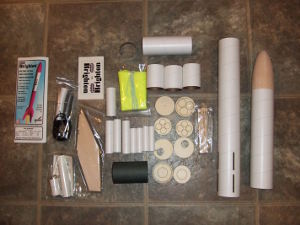
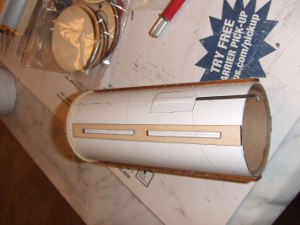
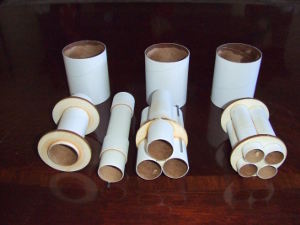
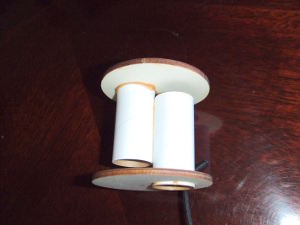
Finishing:
OK, I couldn't subject this beautiful rocket to the magenta/pink color scheme on the cover art, so I went with a
bright orange lower section and nose cone, and a payload that was gloss white with 1/2" black bands top and
bottom. Surface prep was pretty easy with the fins being basswood. I did go through a fair amount of Elmer's Fill 'n'
Finish on the nose cone plus a bit for filling the tube spirals.
There are a pair of Brighton waterslide decals included, and I think Semroc uses some of the best decal material I've ever worked with--the clear really is invisible, and they're just tough enough to handle a little repositioning without being so thick as to be obvious.
I skipped the clearcoat as the weather was pretty lousy when I was trying to finish, something I'd regret after the first flight.
Construction Rating: 5 out of 5
Flight:
With so many motor options to choose from, I could probably log 20 flights without repeating a single one. I figured
I start at the low end of the power curve and work my way up, depending on the drift.
I started with the 4x18mm cluster, and loaded it up with C6-5s. They were close enough together I could probaly have just gone with a twisted wire approach, but I was lazy and pulled out a Sunward clip whip (excellent product).
All 4 lit right away, and the rocket pulled up nice and slowly, allowing me to get a good look at each individual plume of orange flame. It was quite a sight. The rocket was somewhat overstable and weathercocked into the 8 mph wind. The weathercock wound up throwing the trajectory off just enough that the delay was a tad late. In lighter winds, I would imagine the -5s would be fine.
I had prepped a 3x D12-5 for quick reload/reflight but ran out of time and will have to put that one up another day. I had also forgotten my altimeter and would really like to record a few altitudes on the flights using different motor combinations, so the 3xD12-5 will be the first of those.
Recovery:
The 24" Day-Glo yellow nylon chute deployed perfectly, and the rocket drifted back down landing only about 40
yards from the pad. I'd guess the altitude was between 250 and 300 feet. It did land a bit hard, but this is a very
rugged bird.
Upon closer inspection, I picked up a very slight dent at the top of the body tube where it looks like the payload section pulled back a bit harshly. When I looked over the payload, I noticed a bright orange smudge over the white paint, so it was a glancing blow, not a direct shot. Had I bothered to clear coat, I'm sure it would have been fine, but as it is I've now got a slight smudge to an otherwise beautiful finish on the rocket.
I'd also give kudos to the baffle. Normally I don't completely trust baffles and still put in a little dog barf or wadding, but in this case I let it fly without any additional protection. There was not even a trace of smoke or char on the chute, so the baffle caught the charges very well.
I do think I'll add in another 5-6 feet of tubular nylon though, as the heavy elastic cord on this is only about 4 feet long.
Flight Rating: 4 out of 5
Summary:
This is a great overall rocket. The PRO's would be solid quality parts and the amazing variety of interchangeable
motor configuration options.
Cons? Hard to pick on anything, but I'd go with longer shock cord and probably reinforce the D-sized metal clip used to hold in the interchangeable mounts with some masking tape. Clustered ejection charges, especially 24mm motors, are surely going to be more than that one tiny clip can hold in, and the neat little motor cans will wind up flying out the aft end, possibly leading to lack of chute deployment.
Overall Rating: 4 out of 5
Other Reviews
- Semroc Brighton By John Bergsmith (March 27, 2009)
Brief: The Brighton is an upscaled version of the Estes Ranger. The kit features four different interchangeable motor mount options: 4x18mm cluster, 3x24mm cluster, single 29mm, or single 24mm using a 29/24 adapter. The Brighton includes a baffle system to protect the recovery parachute from the ejection gases. Construction: Lots of parts with this kit! BNC 80 balsa ...
 |
 |
Flights
 |
 |